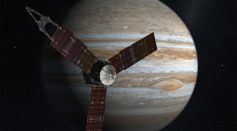Tags: Jupiter
Up in the Sky: Venus, Jupiter, Saturn Captured in Stunning Photos as They All Line Up with the Moon

First 3D View of Jupiter's Atmosphere Shows the Great Red Spot is Deeper Than Expected, NASA's Juno Reveals
NASA Juno Spacecraft Compares Jupiter's Great Red Spot To A Floating Pancake Above the Clouds

NASA Juno Spacecraft Team To Reveal Jupiter’s 3D Atmosphere; What Did The Probe See?
Space Rock Hits Jupiter Yet Again; Here's What Japanese Skywatchers Saw
Jupiter-Like Planet Survives Death of Its Star; How Did It Happen?
NASA Hubble Space Telescope Found Water Vapor in Jupiter’s Europa, Scientists Baffled
Jupiter, Saturn To Join Waxing Moon Tonight; Will Bright Star Antares Show Up?
NASA Lucy Spacecraft to Depart This Week: How to Watch Launch

UAE Eyeing Venus in Its Next Interplanetary Mission Before Studying the Asteroid Belt Between Mars and Jupiter
NASA's Lucy Mission Going to Space Soon to Probe Jupiter’s Weird Trojan Asteroids
Hubble Space Telescope Detects Winds in Jupiter's Great Red Spot Speeding Up to 400 Miles Per Hour, Does This Makes Sense?
Jupiter May Have Solved Mystery of Uranus, Neptune Atmosphere; Absence of Ammonia Explained
Brazilian Amateur Astronomer Sees Unknown Object Exploding in Jupiter; Can You Guess What That Object Is?
Go Skywatching This Week As the Moon Creeps Up to Saturn, Jupiter When They Take the Spotlight
Brown Dwarf Studies Now Easier Through Observations From New Five Objects of Interest
Not Rocky but Fuzzy Core: Cassini Imaging, Recent Research Claim Saturn as a Giant Soupy Planet
Jupiter in Relatively Large, Bright Sight When It Positions Opposite the Sun; Watch As It Happens on August 20

ESA's Juice Spacecraft Arrives in Toulouse Before Departing to Jupiter With Scientific Instruments
Jupiter Experiencing Energy Crisis for Decades, Global Heat Maps Created to Study the Problem
Most Popular

Memory and Learning: How the Brain Stores, Retrieves, and Forgets Information

The Strongest Tornadoes Ever Recorded: Scientific Breakdown of Extreme Tornado Events

Antibiotic Resistance: How It Develops and Why Misuse of Antibiotics Is Dangerous

How Solar Activity Shapes Our Planet: What the Next Solar Maximum Means for Earth




